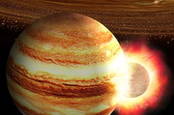This article is more than 1 year old
Astroboffins baffled after spotting solar system with great gas giant that shouldn't exist
Back to the drawing board folks
A gas giant orbiting a tiny red dwarf star thirty light years away has left astronomers baffled because it's not supposed to exist. That's according to a study published in Science on Thursday.
Under the standard model of planet formation, the object known as GJ 3512 b should have never been born as it’s considered almost impossible for low-mass stars like GJ 3512 to harbour massive gas planets. The protoplanetary disk, a rotating jumble of gas and dust around a young star, simply doesn’t contain enough matter to form hefty gaseous planets when the star is small.
But there GJ 3512 b is, floating 30 light years away from us in space. The exoplanet's mass is 1/270 of its parent star's mass, and that's odd, considering Jupiter's mass is 1/1,070 of our Sun's mass. In other words, GJ 3512 b is really massive.
Current theories suggest that planets are grown from smaller bits of debris known as planetesimals glomming together in protoplanetary disks. In order to create a gas giant, a sufficient amount of these planetesimals have to stick together to form a solid core. The rocky centre accumulates gas from the surrounding disk by its gravitational pull, Markus Nielbock, a spokesperson at the Max Planck Institute of Astronomy, who was not explicitly involved in the research, explained to The Register.
“If the disk isn't heavy enough, however, there is not sufficient solid material around that can form those planetesimals quickly enough before they migrate through the disk into the inner regions and eventually fall into the star.”
So how did all that material go into forming gas giants like GJ 3512 b? The global team of researchers believe that the protoplanetary disk must have directly collapsed under its own gravity instead.
In this scenario, GJ 3512 b sprung from material gathered near the outer regions of the disk - beyond 10 astronomical units, or ten times the distance between the Sun and Earth. The temperatures here are very cold, about 10 kelvin (-263 °C), and the outward thermal pressure of the disk cannot counteract the inward gravitational compression. The disk, therefore, collapses under its own weight.
The surrounding material forms a solid core massive enough to accrue gas in the disk so that a planet like GJ 3512 b is possible. These types of disks are described as gravitationally unstable disks. But even this idea doesn’t completely explain the strange system.
Maybe there was a possible third planet?
Gravitationally unstable disks have been discovered, but not around low-mass stars like GJ 3512. “The actual argument is that low-mass stars should not have massive disks. All stars seem to form via a disk of gas and dust. And the mass of the final star is correlated with the mass of the disk from which it emerges. So, it would be quite strange to find massive disks around low-mass stars,” said Nielbock.
The gas giant also orbits its star pretty closely, the maximum distance between both bodies is about half the distance between the Earth and the Sun. So, if it was formed on the outer edges of the disk, it must have eventually migrated inwards.
There is evidence, however, that the system once contained a third planet alongside the GJ 3512 b and the second planet GJ 3512 c, speculated by the researchers. A series of gravitational instabilities led to the ejection of the third planet and brought GJ 3512 b’s orbit closer to it star and more eccentric. It currently completes an orbit in 204 days.
The exoplanet isn’t really that remarkable on its own. But when the researchers consider it alongside its star, they’re flummoxed.
“Until now, the only planets whose formation was compatible with disk instabilities were a handful of young, hot and very massive planets far away from their host stars,” said Hubert Klahr, co-author of the paper and an astronomy professor at the Max Planck Institute for Astronomy. With GJ 3512 b, we now have an extraordinary candidate for a planet that could have emerged from the instability of a disk around a star with very little mass. This find prompts us to review our models.” ®

